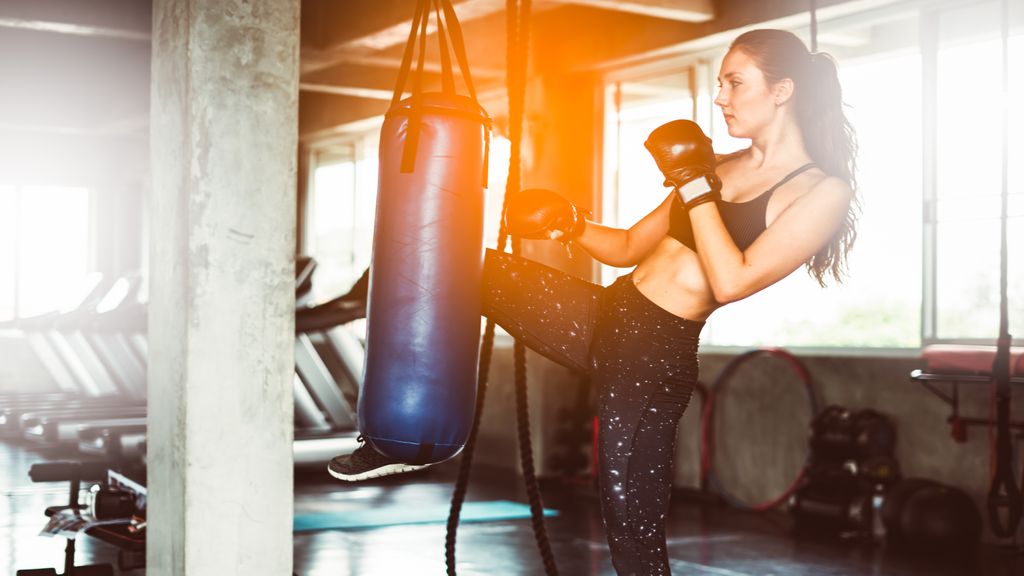
Whether training to break a sweat or preparing for your next competition, kickboxing offers impressive aerobic health benefits and fun. So let’s dive into the aerobic and anaerobic aspects of kickboxing, the health benefits, and your kickboxing options.
Aerobic vs. Anaerobic Exercise: What’s the Difference?
You need both aerobic and anaerobic exercise to be healthy. Aerobic exercise uses large muscle groups, is maintained continuously, and is rhythmic.
Think of movements like:
- Running
- Swimming
- Biking
- Dancing
- Hiking
On the other hand, anaerobic exercise is intense and short in duration.
Think movements like:
- Lifting weights
- Powerlifting
- Olympic weight lifting
- CrossFit
- HIIT
Aerobic exercise requires endurance and increases your heart rate; anaerobic exercise requires strength, power, and intensity. Both are crucial for your health and fitness.
GymBird Beginner Fitness Program
Best for beginner at-home routine
Access our 6 week at-home program, gain a strong fitness foundation, and start feeling your best all for less than the cost of a single month at a gym! Developed and demonstrated by certified personal trainer with over ten years of experience.
Instant access to 6-week workout plan
Demonstration videos for proper form
At-home workouts - minimal equipment needed
Health Benefits of Aerobic Exercise
The benefits of aerobic exercise are tremendous. Regular aerobic activity improves your health in many ways, such as reversing and preventing many diseases, improving your cholesterol, and decreasing your blood pressure.
You can enjoy these health benefits with as little as 150 minutes of moderate-intensity aerobic activity weekly
Lifts Your Mood
Studies have consistently shown that aerobic exercise increases mood. The ‘runner’s high’ many people experience after a long cardio session happens because endorphins (little chemicals in our brain) are released during aerobic exercise and cause temporary euphoria.
Reduces Risk of Chronic Health Conditions
Numerous research studies have demonstrated that regular aerobic exercise dramatically reduces your risk of experiencing a stroke or heart attack, or developing diabetes and many types of cancer.
Many, Many Cardiovascular Benefits
Because aerobic exercise challenges your heart and lungs significantly, it’s no surprise that’s where many of the health benefits occur.
- For example, ample studies have shown that regular participation in aerobic exercise significantly decreases your risk of developing coronary artery disease (CAD) and dying.
- Aerobic exercise also increases your high-density lipoprotein (HDL) levels—the good cholesterol—which decreases your risk of heart disease.
- While you want a high HDL, you want low-density lipoprotein (LDL) and triglycerides. Aerobic exercise helps lower these unhealthy cholesterol components, reducing heart attack and stroke risk.
- Cardiac remodeling is a process that occurs after the heart has been damaged, resulting in structural changes. These changes often lead to a thickening of the heart muscle, causing it to become stiff and less efficient at pumping blood. Amazingly, regular aerobic exercise can slow this process.
- Regular aerobic exercise also reduces blood pressure for those with hypertension and those with normal blood pressure values.
Get our fitness newsletter
Stay on track with your fitness goals and get inspired! Sign up for the GymBird newsletter for twice-monthly expert fitness and nutrition tips.
Health Benefits of Anaerobic Exercise
Anaerobic exercise has loads of health benefits, too. Because of this, the CDC recommends anaerobic activity like strength training for a minimum of two days per week.
Lifts Your Mood
Like aerobic exercise, anaerobic activity boosts mood and energy levels, which can help manage stress and improve mental health.
Fights Aging
Age-related bone and muscle loss (called osteoporosis and sarcopenia) cause significant issues for aging people, including falls, fractures, disability, and a loss of independence. Anaerobic exercises like weight lifting fight aging and frailty by maintaining muscle and bone density.
Builds and Maintains Muscle
Anaerobic exercise is the best way to build and maintain muscle essential for your health and well-being.
Without it, we lose muscle and bone mass each year, and then our metabolism slows down due to that loss. Maintaining a muscular, strong frame prevents age-related disability, keeps your metabolism fires burning, and helps you stay coordinated and balanced.
Improves Body Composition
Research has shown that anaerobic exercise combined with the proper diet will increase muscle mass, which increases resting metabolism by 7% on average.
Because of this muscle-related increase, studies have also shown that those who regularly perform anaerobic exercises like weight training have a lower body fat percentage than non-weight lifters.
Increases Strength and Power
More muscle mass combined with proper training means more strength and power.
Maintaining strength is especially important as you age, as it strongly correlates with decreasing fall risk, fracture risk, and hospital stay length if you are injured.
Improves Insulin Sensitivity
Anaerobic training increases insulin sensitivity, reduces abdominal fat, and improves glycemic control.
Insulin sensitivity and glycemic control are essential because uncontrolled blood sugar may eventually lead to diabetes and other metabolic health conditions.
Is Kickboxing Aerobic or Anaerobic?
Kickboxing is a fighting sport that became popular in the US in the 1970s that involves kicking and punching. Kickboxing is primarily aerobic, but the impact of punching does have anaerobic benefits as well.
If you participate in kickboxing as a combat sport, you will get excellent cardiovascular exercise through near-constant movement and fast footwork.
But you’ll also be trading punches with a sparring partner or a punching bag which gives you those anaerobic perks too.
Kickboxing training focuses on improving your technical ability with punching combinations, skills necessary to avoid punches, and overall fitness. The stamina needed to fight is significant, so you'll also spend plenty of time conditioning with sprints and shuffles.
In addition, you'll also train your core to be strong, balanced, and fast. All these aspects of fitness are required to maintain your energy throughout the fight.
Kickboxing Exercises
Kickboxing originated in Japan as a blend of Muay Thai from Thailand, Karate, and Western boxing.
Multiple types of combat kickboxing exist, including Muay Thai, Lethwei, Dutch, Full-contact Karate, Savate, and Sanda. They differ in their exact contact rules, and which kinds of strikes are allowed.
You don’t need to join the MMA to enjoy the benefits of a kickboxing workout.
The fitness industry has popularized classes, such as shadowboxing and cardio kickboxing, which use movements from the sport to improve fitness. You can get a great workout no matter which type of kickboxing you choose.
Types of Kickboxing
| Muay Thai | Strikes allowed above and below the waist,Focuses on punches, strikes, and kicks. |
|---|---|
| Lethwei | Bare-knuckle fighting allows everything that Muay Thai does, and headbutts |
| Dutch Kickboxing | Allows kicking but emphasizes Western boxing |
| Savate | Originating in France, mostly boxing plus strikes with the feet |
| Sanda | Chinese combat sport that does not allow strikes with elbows or knees |
| Full-Contact Karate | Some styles mix kicking and punching along with sweeps and throws. |
| Shadowboxing | Training exercise where you punch the air to practice combinations and improve fitness |
| Cardio Kickboxing | Combines aspects of fight sports like punching and kicking in a high-intensity aerobic exercise class |
Which type of kickboxing you choose will depend on your athletic goals and risk tolerance. Training in a combat sport can be empowering and bring your fitness to the next level, but it’s not without risks, especially if you plan on competing. So, consult a physician before starting a kickboxing workout routine.
If you want all the fitness benefits of kickboxing without the punches, opt for a cardio kickboxing class or incorporate shadowboxing into your training instead.
Aerobic Kickboxing Exercises
If you want to train like a fighter, you can add these exercises to your next workout to increase your aerobic capacity, stamina, and endurance.
- Burpees
- Ladder drills
- Jumping Rope
- Jumping Jacks
- Mountain Climbers
- Shadowbox and practice your jab, hook, cross, and uppercut punches
- Bear Crawl
- Front Kicks
- Knee Strikes
Anaerobic Kickboxing Exercises
Check out these moves to increase your strength and power.
- Squat jumps
- Push-ups
- Rowing
- Rope Slams
- Kettlebell Swings
- Sprints
- Punch the bag
- Box Jumps
- Med Balls Slams
The Bottom Line
Kickboxing is an incredible aerobic workout with anaerobic benefits depending on the style you chose. The fast-paced footwork and stamina required will increase your fitness and keep you sweating. You can find a kickboxing studio in your area or check out a cardio kickboxing class at your local gym.
More Kickboxing Advice from GymBird Experts
- What is Kickboxing?
- Best Kickboxing Workouts
- Kickboxing Workouts at Home
- Kickboxing for Beginners
- Kickboxing Benefits
Resources
- World Journal of Cardiology. Aerobic vs anaerobic exercise training effects on the cardiovascular system.
- Canadian Medical Association Journal. Health benefits of physical activity: the evidence.
- Brazilian Archives of Cardiology. Cardiac Remodeling: Concepts, Clinical Impact, Pathophysiological Mechanisms and Pharmacologic Treatment.
- Annals of Internal Medicine. Effect of aerobic exercise on blood pressure: a meta-analysis of randomized, controlled trials.
- Current Behavioral Neuroscience Reports. Physical Exercise for Treatment of Mood Disorders: A Critical Review.
- CDC. How much physical activity do adults need?
- Current Sports Medicine Reports. Resistance Training is Medicine, Effects of Strength Training on Health




